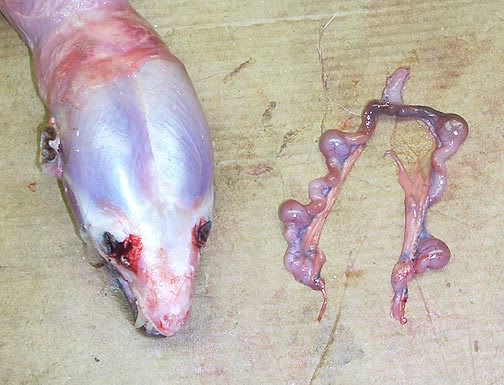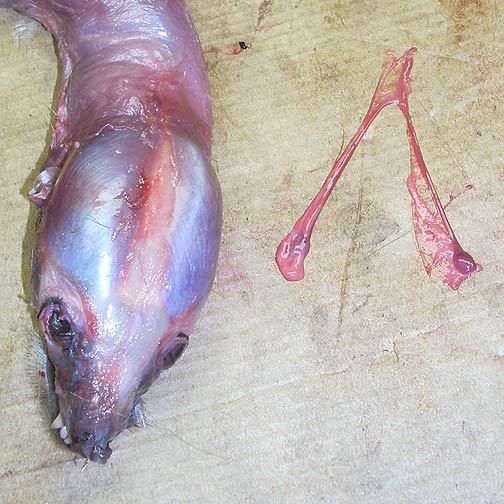|
 Re: Aging Marten
[Re: BAMM BAMM]
#1240645
Re: Aging Marten
[Re: BAMM BAMM]
#1240645
03/08/09 11:01 AM
03/08/09 11:01 AM
|
Joined: Dec 2007
40 years Alaska, now back to O...
alaska viking

"Made it two years not being censored"
|

"Made it two years not being censored"
Joined: Dec 2007
40 years Alaska, now back to O...
|
WOW! 13 years old! I never would have guessed they lived that long. Figured 7-8 was about it. That one must have had all the right moves,(except the last one).
Bearbait; too late. You got the last one.
Just doing what I want now.
|
|
|
 Re: Aging Marten
[Re: white17]
#1241027
Re: Aging Marten
[Re: white17]
#1241027
03/08/09 03:24 PM
03/08/09 03:24 PM
|
Joined: May 2007
Billings, MT
Wolfwoman

trapper
|

trapper
Joined: May 2007
Billings, MT
|
Thank you  Another of my side hobbies...lol I've got a buncha skulls I'm going to clean this spring for myself of various critters and might take a closer look at what I can see as far as age. And the reason I was asking about telling the difference between male and female, is I don't normally get the whole critter so I can't TAKE the easy way out to look and see 
|
|
|
 Re: Aging Marten
[Re: Wolfwoman]
#1652752
Re: Aging Marten
[Re: Wolfwoman]
#1652752
12/12/09 03:14 AM
12/12/09 03:14 AM
|
Joined: Dec 2006
Homer, Alaska
Family Trapper

trapper
|

trapper
Joined: Dec 2006
Homer, Alaska
|
Well I found these photos and thought this would be a good thread to put them on. This was the head from an adult female caught in March. You can see the uterine horns with young starting to form in them. Small circles. Four of them.  The question I would have is in the discrepancy of the next two photos. I would say from the spacing that this is a two year old. Or older?? The uterine horns look mature enough to say perhaps she is getting ready to begin development of her fetus's considering the swollen nature of them or has had a litter the previous year. Which would be my guess. Or is it just the added year of growth that has done this. From my experience in other animals you don't usually see this unless they have either had a litter or in this case perhaps starting to get ready for development..  Opposed to the YOY class with no swollen uterine horns. Or is it a yearling. It is a Feb or March caught Marten. The spacing seems similiar to your photo of the yearling but I would have guess it at a YOY based on relative size to the other marten. ??  Comments from the Marten Guru's
|
|
|
 Re: Aging Marten
[Re: Family Trapper]
#1653039
Re: Aging Marten
[Re: Family Trapper]
#1653039
12/12/09 09:40 AM
12/12/09 09:40 AM
|
Joined: Jan 2009
Idaho, Lemhi County
Gulo

"On The Other Hand"
|

"On The Other Hand"
Joined: Jan 2009
Idaho, Lemhi County
|
Man, I miss all the fun when I go out for a day to check my coyote line...
Great photos White. Your first photo is assuredly an adult female (duh!).
Second photo is definitely an adult as well, post partus (meaning that she has produced young in the past, further meaning that she is probably pregnant again, but the blastocysts have not yet implanted on the uterine walls for the current year). Therefore, a minimum of three years old.
Third photo is YOY, with thread-like uterine horns and would not have produced young during the ensuing year.
With males, it is apparent that the masseter muscle closure method works well. That is, marten from anywhere in North America will show 0-3mm of muscle closure along the sagittal crest if they are YOY taken during the winter (ie, legal season), and will show > 10mm closure if they are ADU. (About 97% accurate).
Females are much more problematic. Some old ADU females (in excess of 3-yr-olds) will not show muscle closure, and size of the uterus should be noted. I see this about 10% of the time, when masseter closure indicates a YOY animal and uterine horn size indicates ADU. Always, when tooth sectioning is completed, these animals are ADU. Thus my earlier comment (on another thread) about the methodology used when looking at harvest ratios.
If any of you (and I would hope all of you) start looking at your catch ratios, I encourage you all to examine the size of the uterus on all females, as this is a better indication of age than length of visible sagittal crest. Also, strive for more than 4 total young (both sexes combined) per every adult female in the harvest.
One of these days I'll take the time to look into posting photos. Once I figure that out, look out!
Again, White, excellent photos to start us on the long journey toward accurate marten aging.
Books for sale on Amazon, Barnes & Noble etc.
Poetic Injustice
The Last Hunt
Wild Life
Long Way Home
Fishin' Stories
|
|
|
 Re: Aging Marten
[Re: white17]
#1653053
Re: Aging Marten
[Re: white17]
#1653053
12/12/09 09:47 AM
12/12/09 09:47 AM
|
Joined: Jan 2009
Idaho, Lemhi County
Gulo

"On The Other Hand"
|

"On The Other Hand"
Joined: Jan 2009
Idaho, Lemhi County
|
Sorry. The photos I was referring to in my last post were from FamilyTrapper. However, same goes; Excellent photos, Len. Many thanks...
Books for sale on Amazon, Barnes & Noble etc.
Poetic Injustice
The Last Hunt
Wild Life
Long Way Home
Fishin' Stories
|
|
|
 Re: Aging Marten
[Re: Gulo]
#1653090
Re: Aging Marten
[Re: Gulo]
#1653090
12/12/09 10:13 AM
12/12/09 10:13 AM
|
Joined: Jan 2009
Idaho, Lemhi County
Gulo

"On The Other Hand"
|

"On The Other Hand"
Joined: Jan 2009
Idaho, Lemhi County
|
White,
Unfortunately, uterine scars are not persistent in marten (unlike wolves, coyotes, etc., where you can determine history of litter size back a few years). Corpora albicantia and corpora lutea are actually ovarian scars (not uterine) where the egg has developed in the ovary, and then been expelled. In marten, the egg is released, fertilized, from the ovary and descends the uterine horn. This fertilized egg develops to the eight-cell stage (the blastocyst) but, unlike most species, does not implant on the uterine wall (thus, the term, delayed implantation) for several months. The blastocysts are basically free-floating in the uterus, with arrested development. They don't start to develop until they implant (usually late winter). Thus, you can flush the blastocysts out of the uterine horns with water and a syringe during most of the winter, and count these little guys, giving an indication of population productivity (had they not been harvested).
It gets real complicated, and most of you are probably rolling your eyes. If there is interest, I'll go farther into this...
Books for sale on Amazon, Barnes & Noble etc.
Poetic Injustice
The Last Hunt
Wild Life
Long Way Home
Fishin' Stories
|
|
|
|
|









